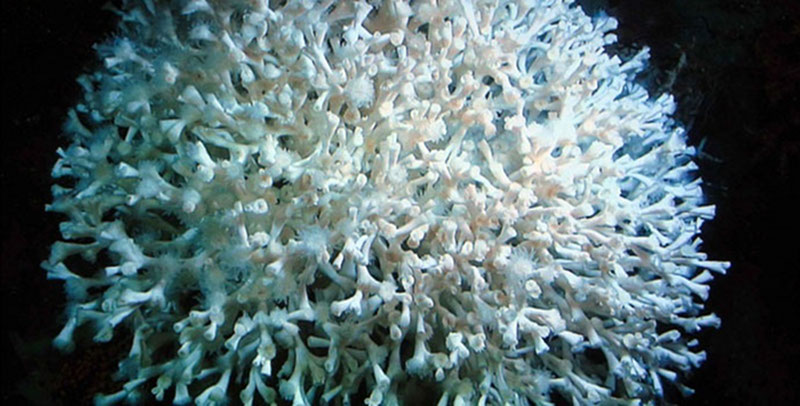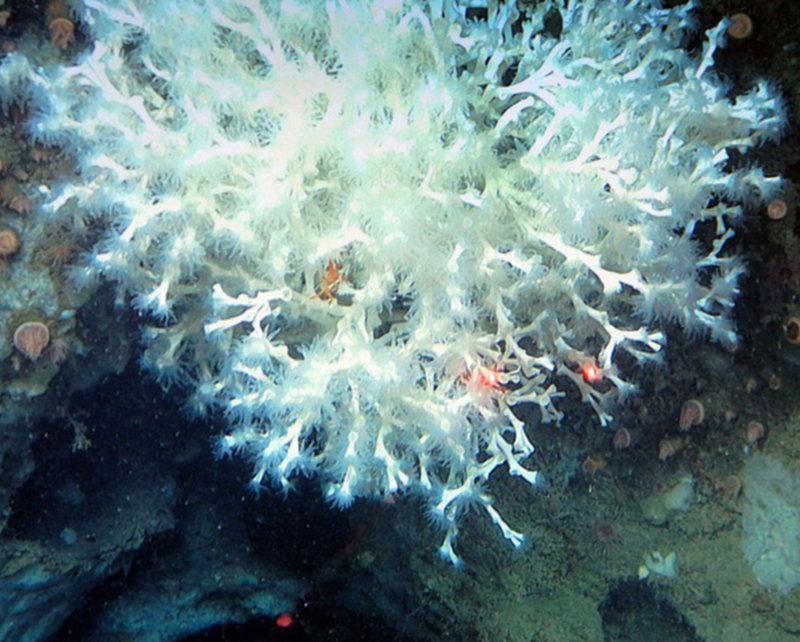
By
Sandra Brooke - Marine Conservation Institute/OIMB
Steve W. Ross - UNC-W, Center for Marine Science
September 13, 2012

First Lophelia colony seen in Baltimore Canyon. Image courtesy of Deepwater Canyons 2012 Expedition, NOAA-OER/BOEM. Download larger version (jpg, 482 KB).
The objective of our dive in Baltimore Canyon was to return to a flat plateau we had seen previously, which had dense colonies of Paramuricea, a target species for our octocoral geneticist, Dr. Scott France.
We successfully collected our coral samples and moved south along the ridge into an area of steep rocky walls with overhangs and deep fissures. The wall was covered in giant colonies of pink and white Paragorgia (bubblegum coral) and several other types of gorgonians in various shapes and colors. Among these there appeared a large fuzzy white ball, which looked odd and different from the others.
As we moved closer, it became more apparent that “the ball“ was a large colony of Lophelia pertusa. The van erupted with various unprintable exclamations of surprise and excitement – this is the first time Lophelia has been seen in Baltimore Canyon!
Further south, this species forms massive reefs that span from North Carolina to the Gulf of Mexico, and it has also been documented further north in the rocky canyons off New England. This fuzzy ball in the depths of Baltimore Canyon has thus filled a gap in our knowledge of the distribution of this important coral species.
After taking small samples with the remotely operated vehicle (ROV), we moved further along the wall in anticipation of more sightings. A few minutes later, we saw two more colonies in a deep crack in the wall. We only saw a total of five Lophelia colonies during the remainder of the dive, but we noticed distinct characteristics in their location and shape; all were very spherical and compact and were found on the underside of overhangs or other areas that were protected from sediment accumulation.

Lophelia colony hanging over a deep fissure in the wall. Image courtesy of Deepwater Canyons 2012 Expedition, NOAA-OER/BOEM. Download image (jpg, 153 KB).
This was our last dive in Baltimore Canyon, so we collected small samples for our genetics, reproduction, isotope, and live coral studies and left the corals in peace until next year.
After the ROV was secured, we steamed down to Norfolk for the last dive of Leg II. We applied what we had learned about the hard corals in selecting the dive location. We picked a site that started around 750 meters and looked steep and craggy with potential overhangs up to 300 meter. Our first hunch paid off and we found a lot of Desmophyllum (the giant cup coral), including several dead ones for paleoecology studies.
Moving up the wall into the Lophelia depth range, we found the right kind of habitat but began to lose hope as the clocked ticked on towards the end of the dive. As we moved along a steep wall being blown by a strong northerly current, a fuzzy white ball whipped along the edge of the video screen. It took a lot of skill to stop the ROV and turn it around in those conditions, but the Kraken2 team did it and sure enough, there was a Lophelia colony nestled between two gorgonians.
This colony was smaller than those in Baltimore Canyon, but just as valuable. We only saw this single colony, but we know there are more out there and will come back next year to continue our search.
This was a fantastic end to an exhausting but very productive cruise; we have learned a lot about the canyons and their inhabitants, but the more we learn, the more we realize we have just touched the surface of the secrets hidden in the deep ocean.